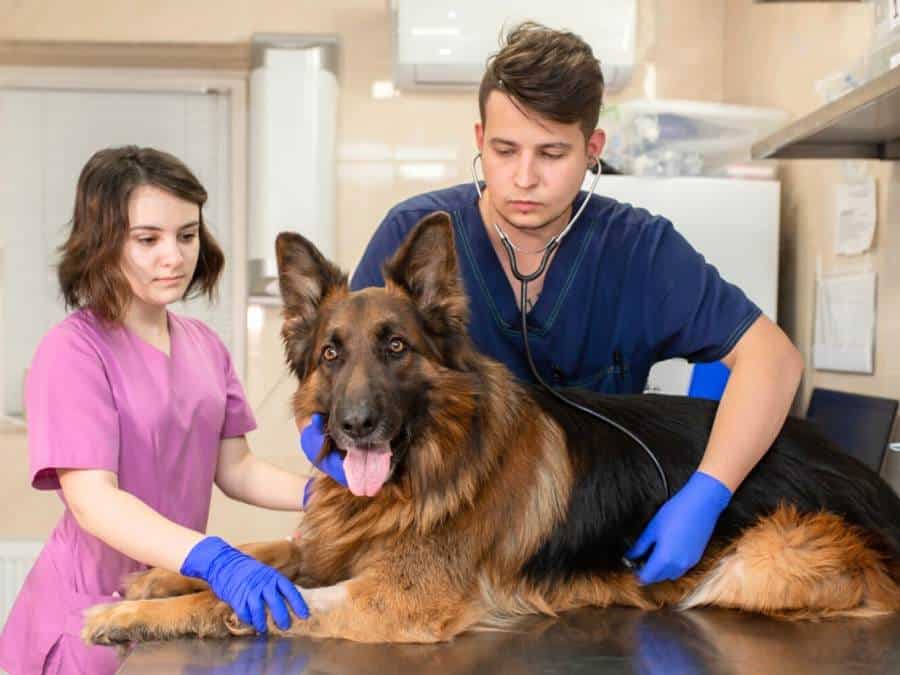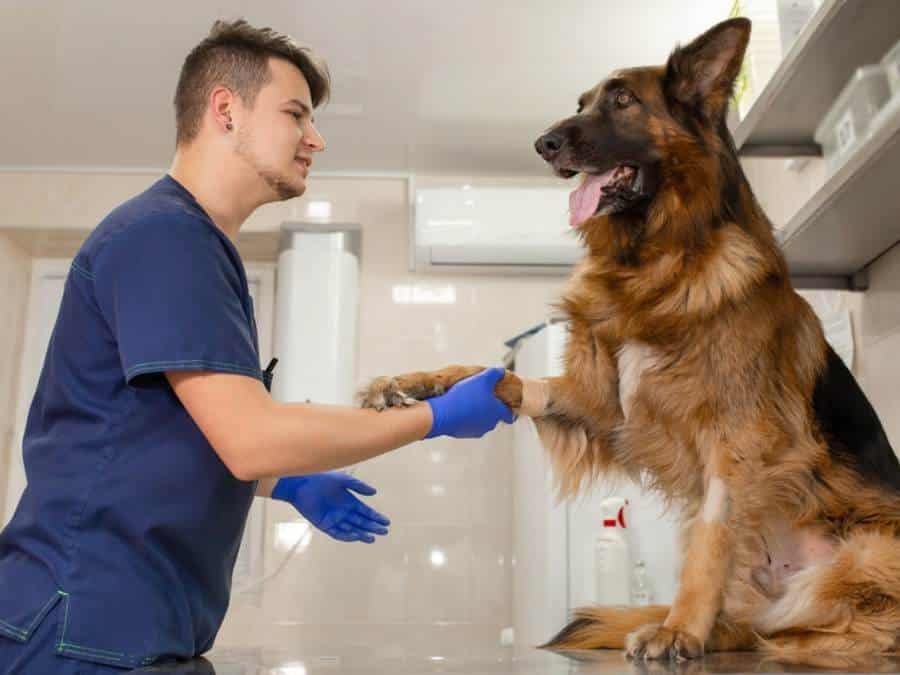Do you want to spay or neuter your German Shepherd? It’s a big decision that needs careful thought and consideration.
There is a lot of conflicting advice floating around, and it’s easy to feel overwhelmed and conflicted as a GSD parent.
So in this article, we will talk about the best age to spay or neuter your GSD, the pros, cons & risks of spaying or neutering. We will also discuss the expected cost and recovery time after the surgery.
Finally, we will shed light on whether or not spaying or neutering solves behavior issues.
Spaying or Neutering Your German Shepherd: Overview
Spaying and neutering are medical procedures that sterilize a dog, making them permanently incapable of reproducing.
The procedure is called spaying for a female GSD and neutering for a male dog.
In female dogs, spaying involves removing the ovaries and uterus, preventing them from going into heat and becoming pregnant.
Neutering a male German Shepherd involves removing his testicles, which are responsible for producing sperm and testosterone.
Neutering or spaying is a risk-free and simple surgical procedure. The entire process from the time anesthesia starts to the time the dog is awake lasts between 30-60 minutes. The surgery itself typically takes about 20 minutes.

When to Neuter or Spay Your German Shepherd
The ideal age for dog neutering depends on several factors, including the gender, breeding considerations, and behavior and health of your pup.
There is no one-size-fits-all answer!
So, at what age you should neuter/spay your German Shepherd?
In general, most veterinarians recommend neutering male German Shepherds between six to nine months of age.
For female German Shepherds, it is typically recommended to spay them before their first heat cycle, which usually occurs around six months of age.
RELATED:
- What is the Life Expectancy of a Female German Shepherd?
- German Shepherd Heat Cycle: Length, Frequency, & Stages
Factors to consider when determining the timing of neutering/spaying
- Consult with Your Veterinarian: Your vet is the best person to ask for advice. They can evaluate your dog’s health, breed, and lifestyle to give you personalized recommendations.
- Gender Matters: The ideal timing can vary between males and females. Male German Shepherds can typically be neutered around six to nine months of age, but consult your vet for the best timing. For females, it’s generally recommended to spay them before their first heat cycle, but again, consult with your vet for the most appropriate timing.
- Consider Your Dog’s Health: Some health conditions may influence the timing of spaying or neutering. Your vet can help you weigh the pros and cons.
- Reproductive Considerations: If you’re not planning to breed your German Shepherd, it’s a responsible decision to have them spayed or neutered. However, if you do have plans to breed, it’s important to seek guidance from an experienced breeder regarding the best timing for this procedure.
- Behavioral Considerations: Neutering can have an impact on certain behaviors, such as aggression, roaming, and marking territory. Discuss these concerns with your vet.
- Your lifestyle: Consider your lifestyle and ability to manage an intact dog. If you have the time and resources to responsibly care for an intact dog, you may choose to delay the procedure.
- Local Laws and Regulations: In some places, there may be laws or regulations regarding the timing of spaying or neutering.

What is the Cost of Neutering or Spaying Your German Shepherd?
The costs of spaying and neutering your German Shepherd can vary significantly based on factors like location and the age and size of your dog.
The German Shepherd spaying/neutering cost also depends on whether you choose to have the procedure done at a private veterinary clinic or a low-cost spay/neuter clinic.
On average, spaying a female German Shepherd can range from approximately $200 to $500 or more at a private veterinary clinic in the United States.
Neutering a male German Shepherd is often less expensive, with costs ranging from approximately $150 to $400.
However, opting for low-cost spay/neuter clinics operated by animal welfare organizations can significantly reduce these expenses, with prices sometimes as low as $50 to $200.
The cost of the procedure may include additional services such as anesthesia, pain medications, and sometimes a post-operative check-up.
It’s crucial to discuss the specific costs and services included with your chosen veterinary clinic or spay/neuter program beforehand.
RELATED:

German Shepherd Neutering/Spaying Pros & Cons
Pros/Benefits of Neutering a Male German Shepherd
- Neutering helps control the pet population by preventing unwanted litters.
- Neutering can often result in a reduction of certain undesirable behaviors such as marking territory with urine, aggression, and roaming in search of a mate. It may also reduce the likelihood of certain dominance-related behaviors.
- Neutering may reduce the risk of certain health issues, such as testicular cancer and prostate problems. It may also decrease the risk of certain behavioral problems that can lead to injuries, such as fights with other dogs.
- Neutered dogs may be less likely to roam in search of a mate, reducing the risk of accidents, injuries, and getting lost.
- Neutered males may exhibit better social behavior with other dogs, as the absence of hormonal influences can reduce territorial aggression and dominance-related behaviors.
Pros/Benefits of Spaying a Female German Shepherd
- Spaying eliminates the risk of unplanned pregnancies, which is especially important if the dog is not intended for breeding purposes.
- Spaying significantly reduces the risk of certain reproductive-related health problems, such as uterine infections (pyometra) and mammary tumors.
- Spaying can lead to a reduction in certain behaviors associated with the reproductive cycle, such as the attraction of males during heat, restlessness, and irritability.
- Female GSD heat cycles can be messy and attract unwanted attention from intact males. Spaying eliminates heat cycles.
- Spaying can reduce the urge to roam in search of a mate during their heat cycles minimizing the risk of accidents, injuries, or getting lost.
- Spaying may decrease the risk of certain reproductive cancers, including ovarian and uterine cancers.
RELATED: German Shepherd Cancer Symptoms
Cons of Neutering a Male German Shepherd
- Neutered dogs tend to become less protective or lose some of their natural guarding instincts.
- Neutered dogs may be more prone to weight gain.
- Neutering before full maturity may lead to delayed closure of growth plates, potentially affecting the development of bones.
- Neutering before maturity might also affect muscle development.
- Neutering can sometimes lead to changes in coat texture or color.
Cons of Spaying a Female German Shepherd
- Just like males, spayed females may become prone to weight gain.
- Spaying before maturity might affect muscle development in females too.
- Spayed females may have a slightly higher risk of urinary incontinence.
German Shepherd Neuter/Spay Surgery Procedure

Your veterinarian will usually offer pre-surgical blood work to make sure your dog is healthy enough for surgery and doesn’t have any health conditions that would affect the choice of anesthesia.
Once your dog is ready, a trained professional will guide you through each step of the surgical process. Here is a general outline of what typically occurs:
- Anesthesia administration: Your dog will be given anesthesia to ensure they remain unconscious and pain-free throughout the procedure.
- Preparation: The surgical site will be cleaned and shaved in order to maintain sterility during the operation.
- Incision: The veterinarian will make a small incision near the scrotum or midline abdomen (for female dogs) in order to access and remove reproductive organs.
- Removal of reproductive organs: In male dogs, both testicles are removed through this incision while in female dogs, both ovaries are removed along with the uterus (spaying).
- Closure: The incision is carefully sutured closed using absorbable stitches that do not need to be removed.
- Recovery: Your dog will be monitored closely as they wake up from anesthesia. Once fully conscious, they will be kept in a warm and quiet recovery area.
Potential Risks of Neutering or Spaying
When it comes to spaying or neutering, there are a few potential risks to keep in mind, just as with any surgery. Here are a few things to keep in mind:
- Anesthetic risks: Your dog will be sedated throughout the procedure, and issues such as breathing difficulties, allergic responses, or unpleasant reactions to the anesthesia are possible.
- Infection: Any surgical procedure carries a risk of infection. Proper sterile techniques during surgery and post-operative care can minimize this risk.
- Bleeding: There is a small danger of bleeding with any procedure. During the surgery, your veterinarian will take efforts to reduce any bleeding and will follow your dog afterward.
- Pain: Some GSDs may experience bleeding during or after surgery. Your veterinarian will provide pain medication to alleviate any discomfort.
- Adverse reactions to medications: Some dogs may have an adverse reaction to the surgery, such as vomiting, diarrhea, lethargy, or loss of appetite, in rare situations. Veterinarians consider the pet’s medical history and monitor for any adverse reactions.
It’s important to keep in mind that these risks are usually not serious, and getting your dog neutered or spayed is considered a safe procedure when done by a certified and skilled vet.
Your vet will take precautions to minimize any dangers and will give you instructions for after the surgery to help with healing and recovery.

Recovery From Neutering/Spaying in German Shepherds
After the surgery, expect some mild discomfort and restlessness in your German Shepherd for a few days, but recovery is generally smooth.
However, it’s crucial to limit your dog’s activity for approximately two weeks. This gives enough time for the surgical area to heal properly.
Engaging in activities like running and jumping can result in stitches tearing or causing inflammation and bleeding, which can hinder the healing process.
It’s really important to make sure your dog doesn’t lick the cut. When they lick it, it can get irritated and bacteria can get in, which can cause an infection.
Some dogs might even chew out their stitches, and that might mean they need another surgery to close up the wound.
For this reason, many vets recommend using an e-collar after surgery. This is the conical collar jokingly called the “cone of shame.”
Often, dogs are given a few days’ worth of pain medication to take home. It’s important to follow the prescribed dosage even if your dog seems fine, because these medications help reduce inflammation and can prevent pain and inflammation from becoming a recurring issue.

How To Care For a GSD After Spaying/Neutering
Taking care of your dog after surgery is crucial for a smooth and comfortable recovery. Here are some general guidelines, but it’s important to follow your veterinarian’s specific instructions.
- Create a quiet and comfortable space for your dog to rest and recover. Ensure they have a soft bed or blanket.
- Keep their incision clean and dry, and keep a close eye for signs of infection, swelling, redness, or discharge.
- Prevent your dog from licking or chewing the incision. Your vet may provide this Comfy Cone Pet Cone, an Elizabethan collar (cone) to prevent this.
- Avoid strenuous exercise, running, and jumping during the initial recovery period.
- Keep an eye on your dog’s appetite and encourage them to drink water.
- Administer any prescribed medications according to your veterinarian’s instructions.
- Attend any follow-up appointments scheduled by your veterinarian to monitor the healing process and address any concerns.
- Offer your dog comfort and reassurance during the recovery period. Spend time with them, but also allow them to rest.
Always contact your veterinarian if you have any concerns or notice unusual symptoms during the recovery process.
Common Doubts That GSD Owners Have About Spaying/Neutering
1. Does neutering or spaying a German Shepherd stunt growth?
Neutering or spaying a German Shepherd is unlikely to significantly stunt growth. The impact on growth is more related to the timing of the procedure; early neutering may slightly affect the growth plate closure, but the overall effect is generally minimal.
2. Do German Shepherds calm down after neutering/spaying?
Neutering may contribute to a reduction in certain behaviors linked to hormones, such as aggression and roaming. While it can have a calming effect on some dogs, individual variations in temperament and behavior may still occur.
3. How does neutering affect a German Shepherd?
Neutering can have several effects, including a reduced risk of certain health issues, such as testicular cancer in males and mammary tumors in females, and potential improvements in behavior. However, it’s essential to consider individual differences and consult with a veterinarian for personalized advice.
4. What are the signs that my German Shepherd needs to be neutered?
Signs that your German Shepherd may benefit from neutering include behavioral issues like aggression, excessive marking, or unwanted roaming. Additionally, if you’re not planning to breed your dog and want to prevent unwanted litters, neutering is a suitable option.
5. How will neutering or spaying affect my German Shepherd?
Neutering or spaying can have health benefits, reduce the risk of certain cancers, and address behavioral issues. However, the impact varies between individuals, and consulting with a veterinarian will help you make an informed decision based on your dog’s specific needs.

6. Should I neuter my German Shepherd dog?
Whether to neuter your German Shepherd depends on factors such as health, behavior, and your own preferences. Consulting with a veterinarian can help you weigh the pros and cons and make the best decision for your dog and your lifestyle.
7. How soon can you spay a German Shepherd?
The optimal age for spaying a German Shepherd is usually around 6 months, but individual factors and the veterinarian’s recommendation play a role. Waiting until the dog is fully mature may also be considered to allow for proper development.
8. Are there any alternatives to spaying and neutering?
Yes, there are alternatives to traditional spaying and neutering, but their suitability depends on your specific circumstances and goals. Here are some alternatives to consider:
1. Tubal Ligation and Vasectomy
These are surgical procedures that sterilize dogs without removing their reproductive organs. Tubal ligation involves blocking or sealing the fallopian tubes in females, and vasectomy involves blocking the vas deferens in males.
While these procedures prevent reproduction, they do not impact hormone production, and some behavioral benefits of spaying/neutering may still be achieved.
2. Hormonal Treatments
Medications that suppress reproductive hormones can be used to control the heat cycle in females or reduce certain male behaviors. However, these medications are not a permanent solution, and long-term use may have side effects.
3. Supervision and Management
Keeping intact males and females separate when they are in heat or when you are not actively breeding them can prevent unwanted pregnancies without surgery.
It’s important to note that each alternative has its own set of considerations and potential drawbacks. The decision to use an alternative should be made in consultation with your veterinarian, taking into account your dog’s health, behavior, and your own preferences.

What Research Shows About Spaying-Neutering German Shepherd
*Please note that this is not an exhaustive review of all research on spay and neutering, and you should always talk to your vet about this decision.
This German Shepherd neutering study published in Veterinary Medicine and Science examined 1170 intact and neutered German Shepherd Dogs over 14.5 years for joint disorders and cancers associated with neutering.
The study found that neutering or spaying these dogs before 1 year of age triples the risk of one or more joint disorders — particularly for cranial cruciate ligament, or CCL, tears.
German Shepherds were studied for joint disorders and cancers, including hip dysplasia (HD), cranial cruciate ligament tear (CCL), lymphoma, hemangiosarcoma (HSA), mast cell tumor (MCT), and urinary incontinence in females.
Increased risk of Joint disorders (Hip and elbow dysplasia, CCL)
- In intact males, 7% were diagnosed with one or more joint disorders, while males neutered before a year of age had a significantly higher rate of 21%.
- Intact females had a 5% joint disorder incidence, whereas females neutered before a year had a significantly increased rate of 16%.
- Early neutering, particularly before a year, was associated with an increased incidence of cranial cruciate ligament tear (CCL) in both males and females.
Lower risk of cancer
- Mammary cancer occurred in 4% of intact females but less than 1% in females neutered before 1 year.
- The incidence of other cancers followed up to 8 years of age did not show a significant increase in neutered dogs compared to intact dogs.
Higher risk of urinary incontinence in female dogs
- Urinary incontinence was not diagnosed in intact females, but was found in 7% of females neutered before 1 year, indicating a significant difference.
The study suggests that early neutering may be associated with an increased risk of joint disorders, particularly CCL, and urinary incontinence in German Shepherd Dogs.
Conclusion
So this was our comprehensive guide on German Shepherd neutering or spaying. By now, you should have a clear understanding of what neutering/spaying is, why it is important, and what to expect during and after the procedure. We’ve covered the right timing for neutering or spaying, the potential risks involved, and how to care for your furry friend during their recovery.
Remember, neutering not only helps control the pet population but also offers several health benefits for your canine companion. By choosing to neuter or spay your dog, you are taking a responsible step towards their well-being and contributing to the welfare of other animals.
Sources:
- UC Davis – When Should You Neuter Your Dog to Avoid Health Risks?- https://www.ucdavis.edu/news/when-should-you-neuter-your-dog-avoid-health-risks
- UC Davis – Big Dogs Face More Joint Problems if Neutered Early – https://www.ucdavis.edu/news/big-dogs-face-more-joint-problems-if-neutered-early
- National Library of Medicine – Assisting Decision-Making on Age of Neutering for 35 Breeds of Dogs: Associated Joint Disorders, Cancers, and Urinary Incontinence – https://www.ncbi.nlm.nih.gov/pmc/articles/PMC7359819/
- American Veterinary Medical Association – When should we neuter dogs? – https://www.avma.org/javma-news/2021-03-01/when-should-we-neuter-dogs
Also read:




